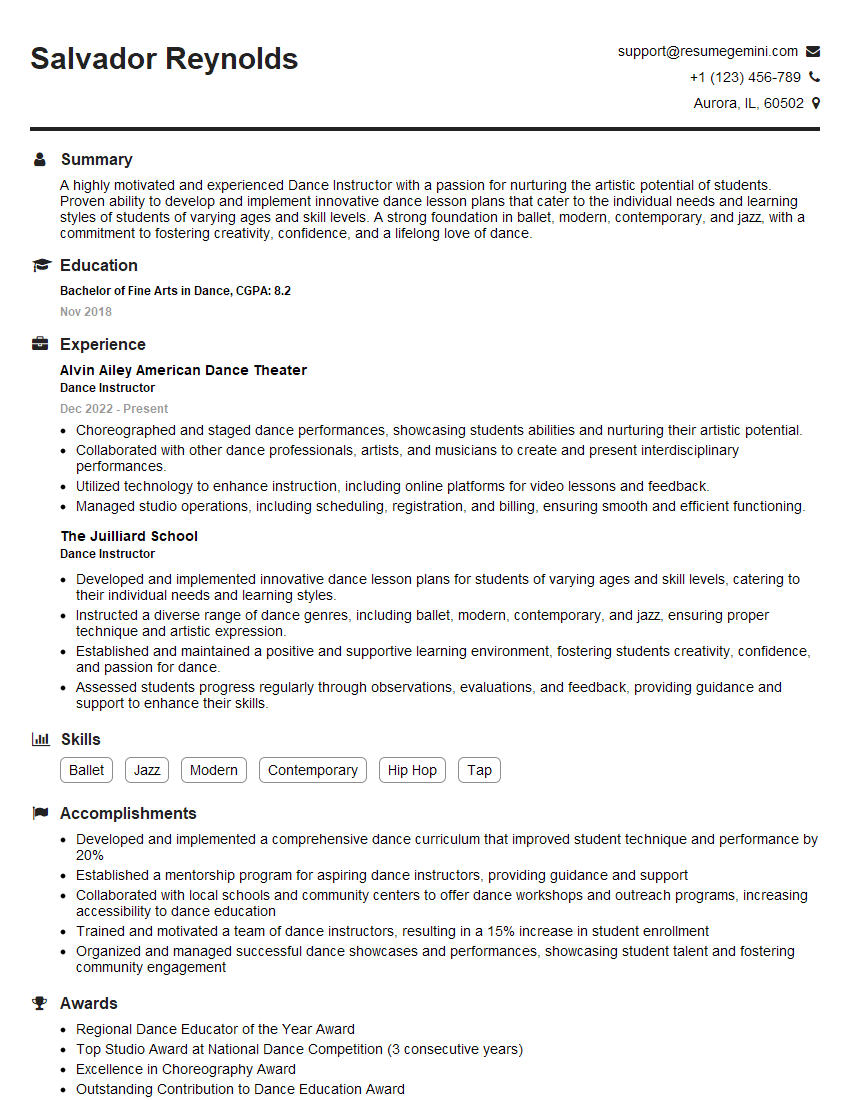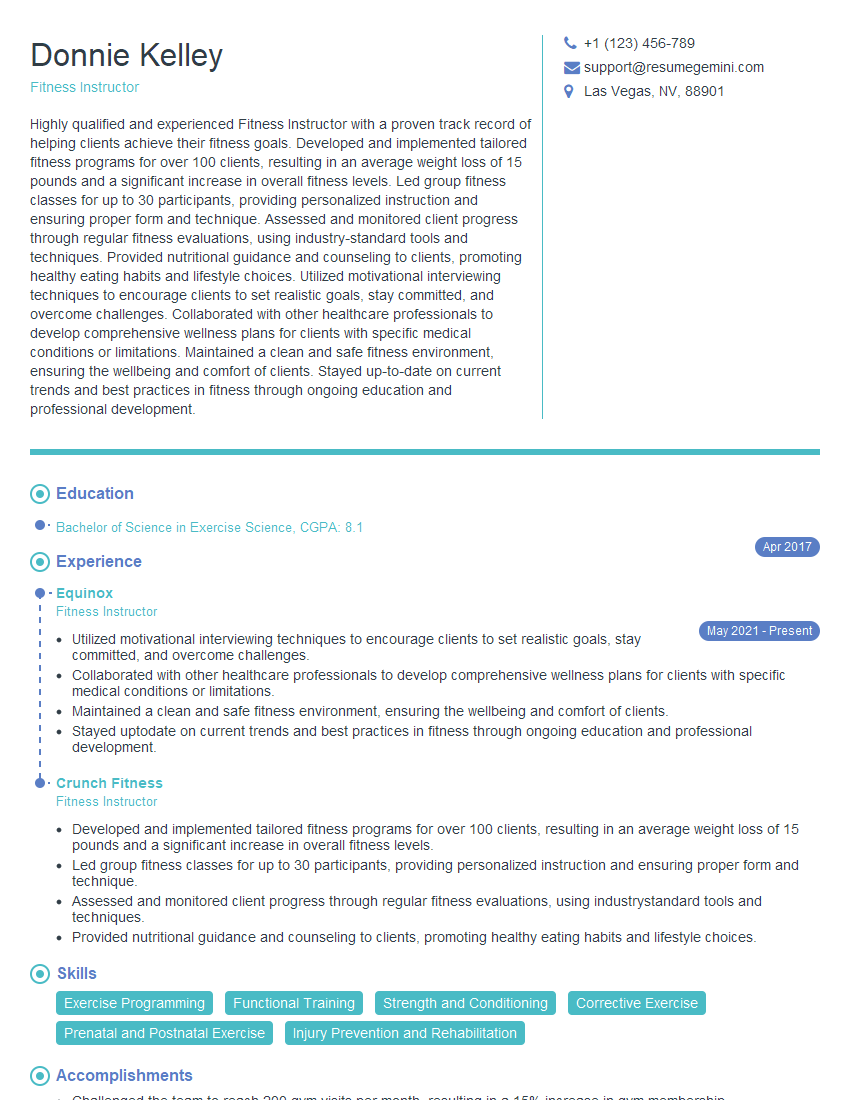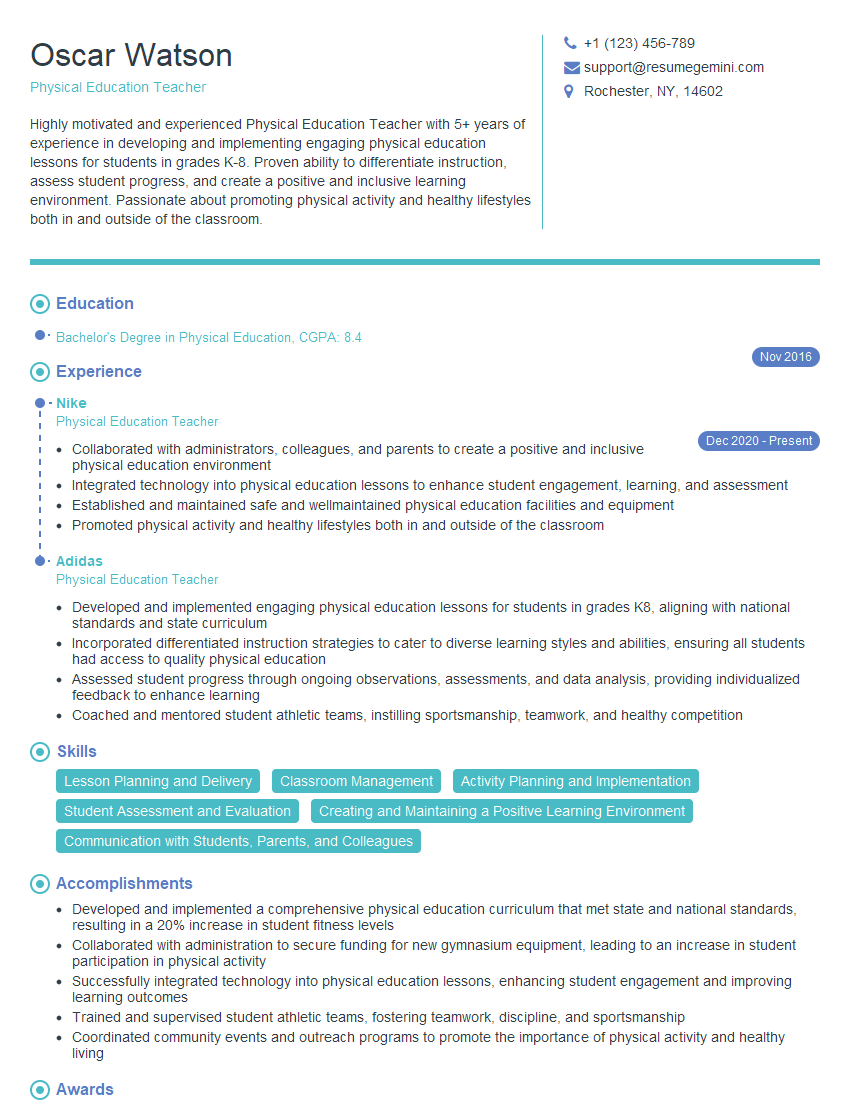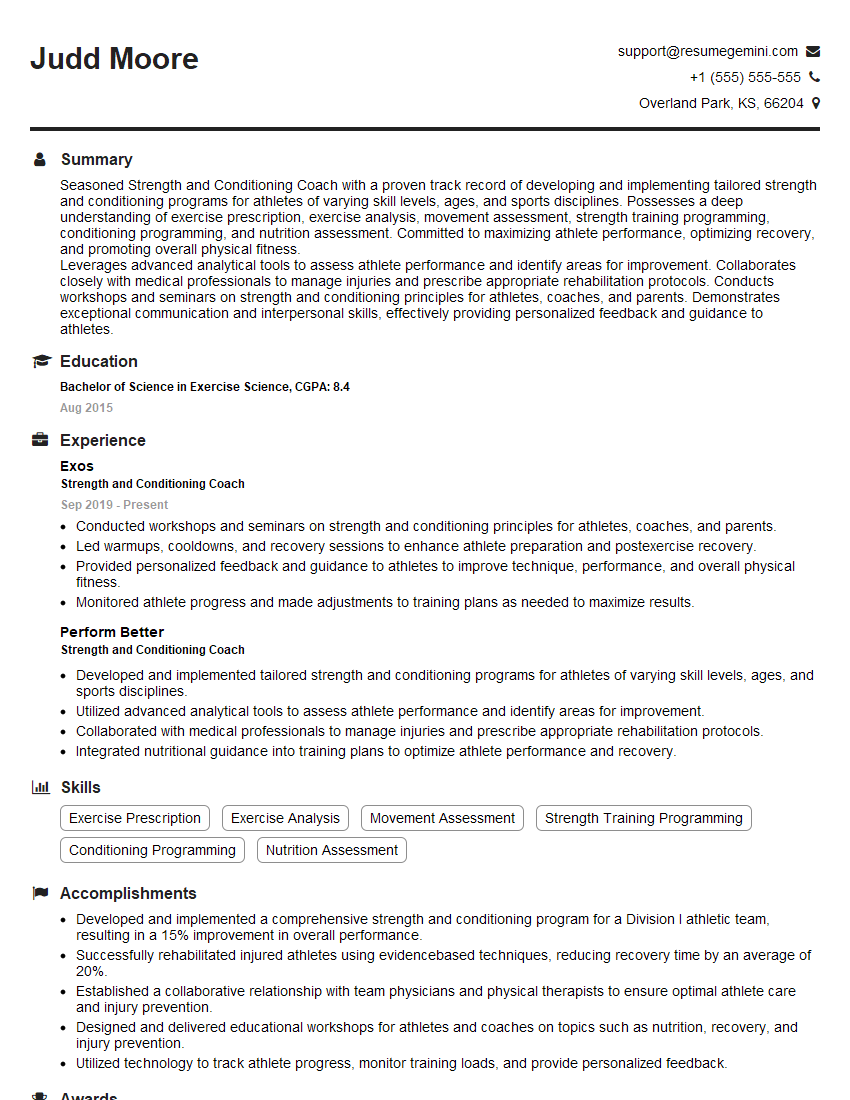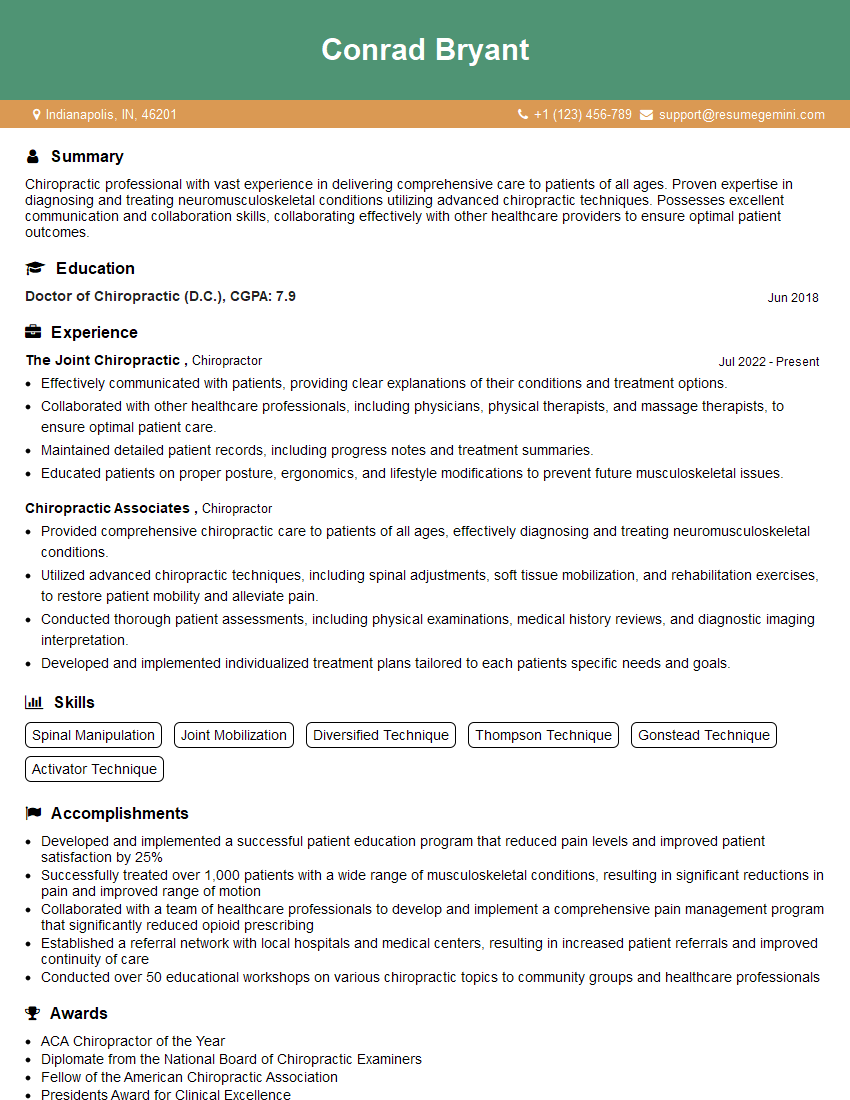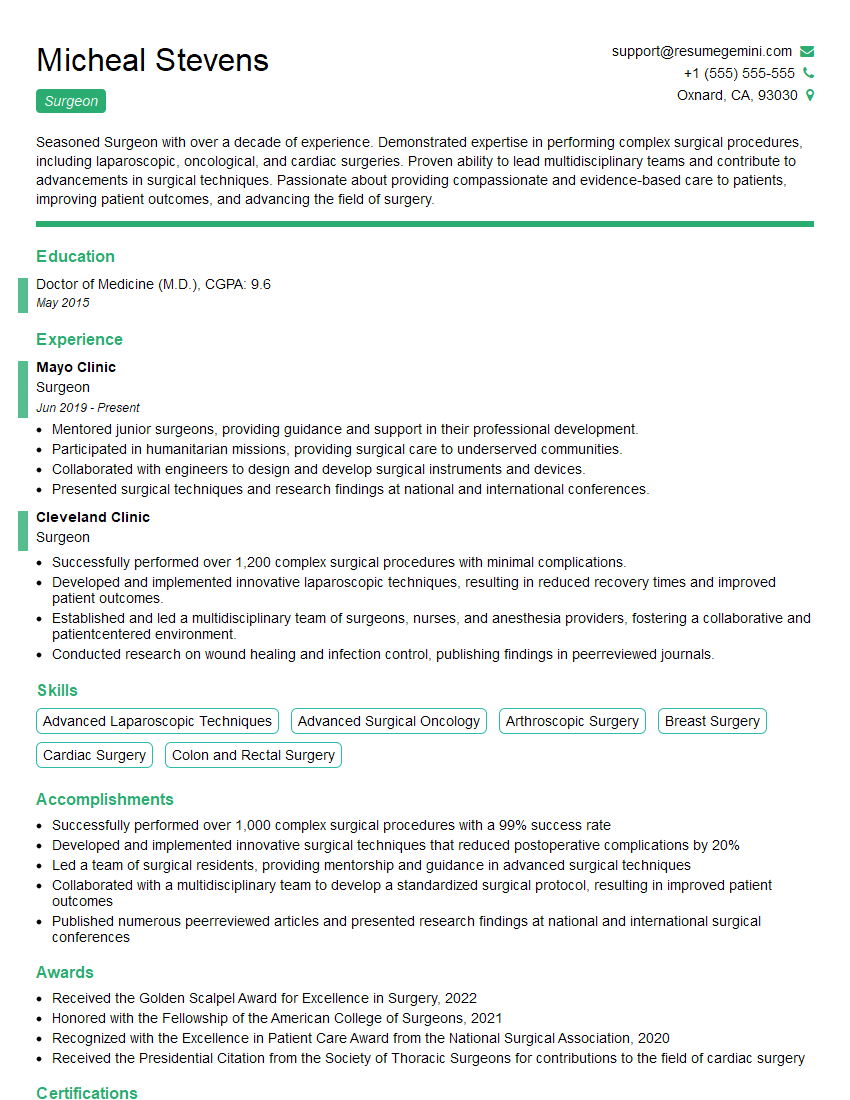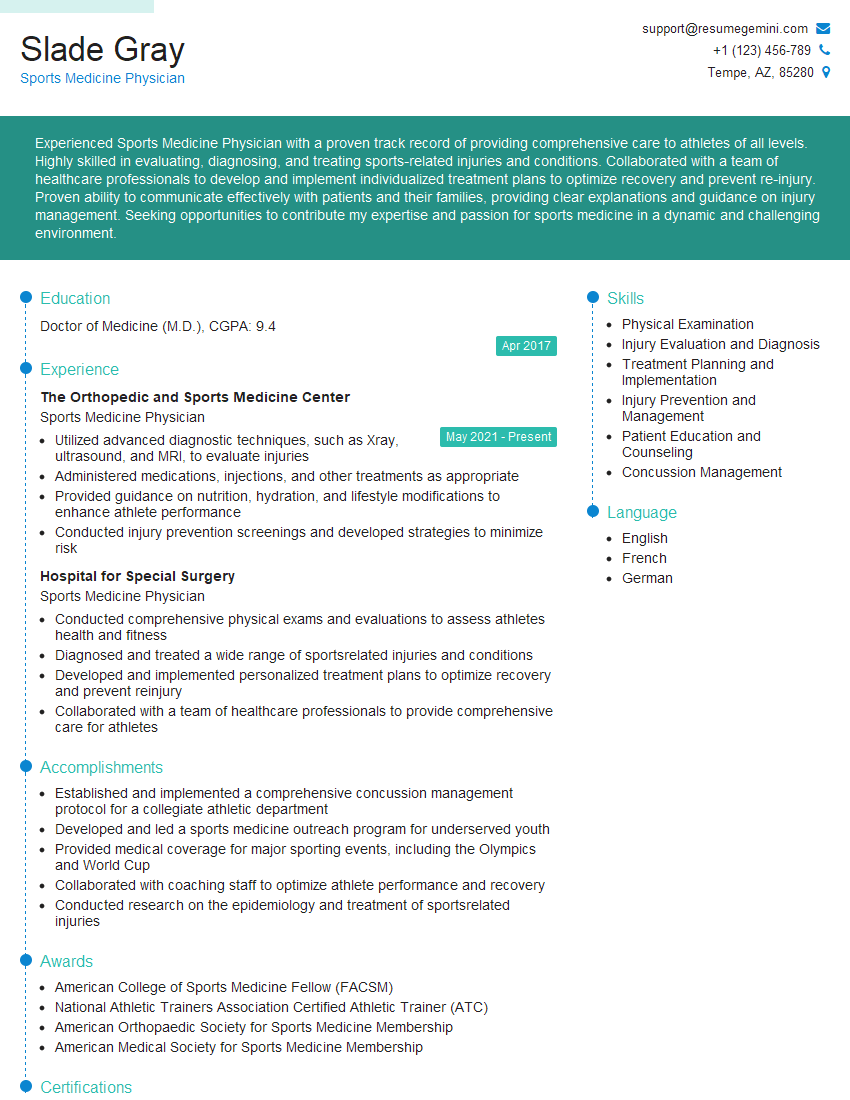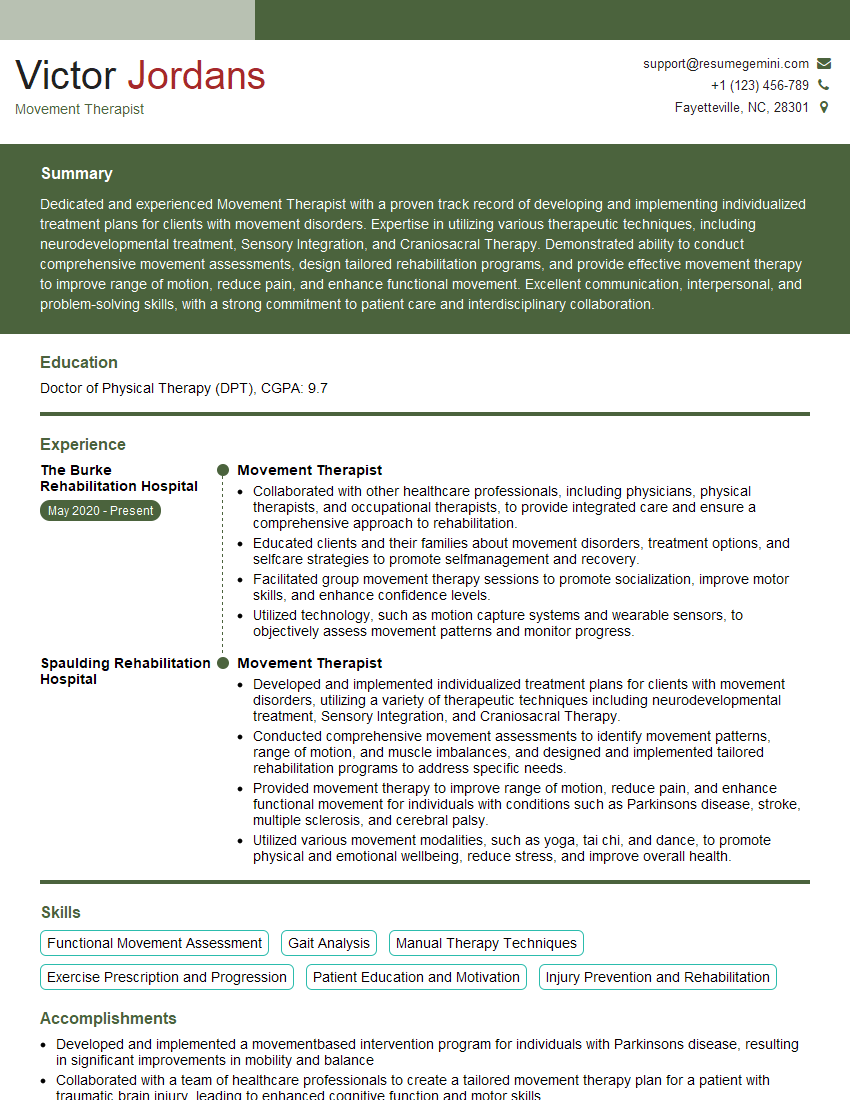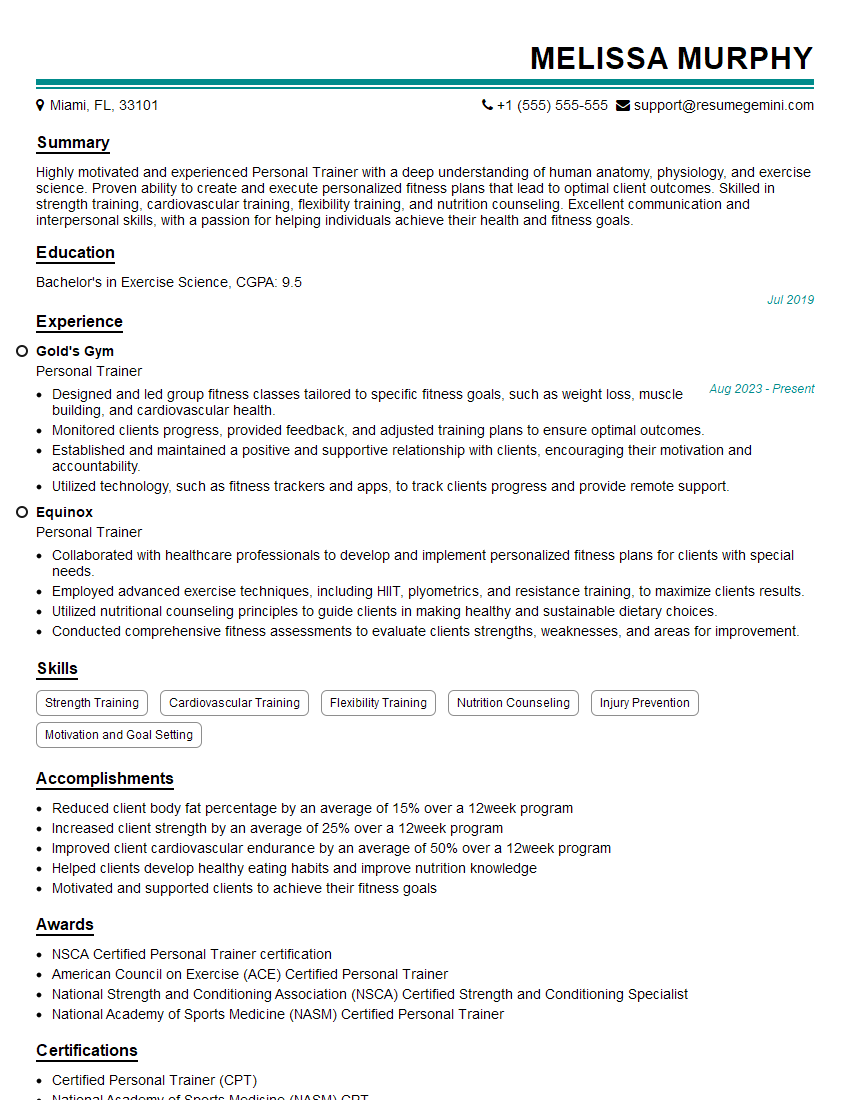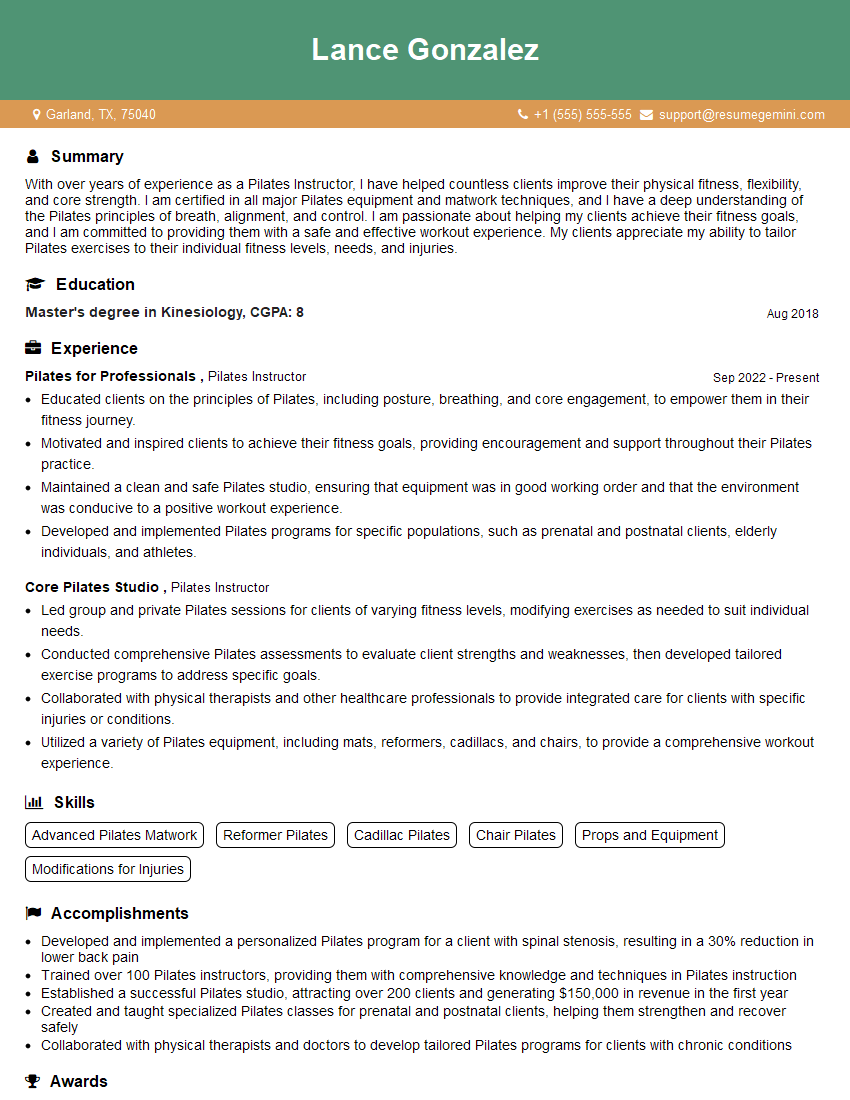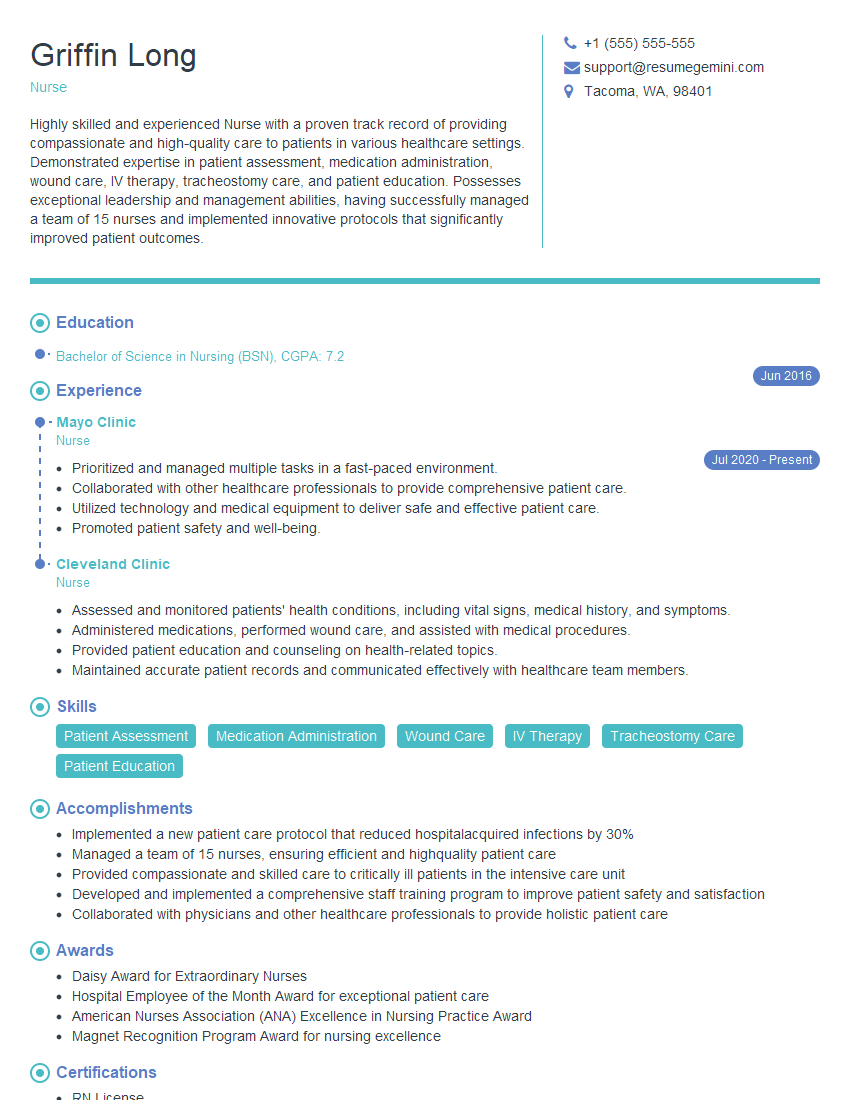Are you ready to stand out in your next interview? Understanding and preparing for Physical Agility and Coordination interview questions is a game-changer. In this blog, we’ve compiled key questions and expert advice to help you showcase your skills with confidence and precision. Let’s get started on your journey to acing the interview.
Questions Asked in Physical Agility and Coordination Interview
Q 1. Describe the components of physical agility.
Physical agility is the ability to perform rapid, whole-body movements with precision and control. It’s not just about speed, but also the efficiency and effectiveness of those movements. Think of a basketball player swiftly changing direction to avoid a defender, or a gymnast executing a complex routine – both demonstrate high agility.
- Speed: The rate at which movements are executed.
- Balance: Maintaining equilibrium while moving.
- Coordination: The ability to smoothly integrate multiple body segments to perform a movement.
- Power: The ability to generate force quickly.
- Flexibility: The range of motion in the joints.
- Reaction time: The time it takes to respond to a stimulus.
These components interact and influence one another. For instance, improved flexibility can contribute to better balance and speed, leading to enhanced agility overall.
Q 2. Explain the relationship between physical agility and coordination.
Physical agility and coordination are intrinsically linked; coordination is a fundamental component of agility. Agility requires the seamless integration of multiple body parts to perform rapid and precise movements. Coordination is the mechanism that allows for this integration – it’s the ability to combine the actions of different body parts to produce a smooth, controlled motion. Without good coordination, even with speed and strength, agility suffers significantly. Imagine trying to dribble a basketball – speed and strength are helpful, but without coordinated hand-eye coordination and footwork, you’ll likely fumble the ball.
Q 3. How do you assess an individual’s physical agility?
Assessing physical agility involves a combination of tests measuring its key components. There isn’t one single definitive test. The appropriate assessment depends on the specific demands of the activity or profession. Here are some common methods:
- T-test: Measures speed and agility through a shuttle run pattern.
- Illinois agility test: Evaluates speed, agility, and change of direction.
- Hexagon test: Assesses speed and agility in a lateral movement pattern.
- Balance tests (e.g., stork stand): Measure static and dynamic balance.
- Reaction time tests (e.g., ruler drop test): Determine the speed of response to a stimulus.
For athletes, specialized tests are employed reflecting the sport’s specific demands. For example, a soccer player might undergo tests assessing their ability to rapidly change direction with the ball.
Q 4. What are the key factors affecting coordination?
Coordination is influenced by several interacting factors:
- Neuromuscular efficiency: The effectiveness of communication between the nervous system and muscles. Problems here can lead to poor motor control.
- Proprioception: The awareness of body position and movement in space. Deficits in proprioception can significantly impair coordination.
- Strength and flexibility: Adequate muscle strength and flexibility are necessary for controlled movements. Weakness or tightness restricts range of motion and limits coordination.
- Age: Coordination generally peaks in young adulthood and declines with age, although this can be slowed by regular exercise.
- Fatigue: As fatigue increases, so does the risk of coordination errors.
- Mental state: Stress, anxiety, and distraction can negatively affect coordination.
Q 5. Explain the difference between static and dynamic balance.
The difference between static and dynamic balance lies in the presence or absence of movement:
- Static balance is the ability to maintain equilibrium while stationary. Think of standing on one leg.
- Dynamic balance is the ability to maintain equilibrium while in motion. Think of walking on a balance beam or riding a bicycle. It involves constantly adjusting posture to compensate for changes in center of gravity.
Both types of balance are essential for agility. Static balance provides a stable base for rapid movements, and dynamic balance allows for controlled changes in posture during agile maneuvers.
Q 6. How can you improve reaction time?
Improving reaction time requires consistent practice and training targeting both physical and cognitive aspects:
- Reaction time training exercises: Using tools like reaction balls or online reaction time tests provides focused practice.
- Plyometrics: Exercises like jump squats and box jumps improve muscle activation speed.
- Agility drills: Activities requiring quick changes of direction enhance neural pathways responsible for rapid responses.
- Cognitive training: Activities enhancing focus, attention, and processing speed positively affect reaction time.
- Adequate sleep and nutrition: These are crucial for optimal nervous system function and performance.
Consistent, focused practice is key. Start with easier drills and gradually increase difficulty. Regular training is more effective than sporadic bursts of intense effort.
Q 7. Describe different methods for measuring agility.
Numerous methods exist for measuring agility, catering to different contexts and needs:
- Timed agility tests: These involve navigating a course (e.g., T-test, Illinois agility test) under timed conditions.
- Agility course completion time: Simple courses incorporating obstacles, cones, and changes of direction are used to assess time taken for completion.
- Technology-based methods: Motion capture systems, wearable sensors (GPS, accelerometers), and video analysis provide precise and objective measurements of movement parameters (speed, acceleration, changes in direction).
- Sport-specific tests: These tests replicate movements frequently seen in a particular sport (e.g., shuttle runs in basketball).
The choice of method depends on the specific requirements and resources available. For example, a researcher may use motion capture technology for detailed analysis, whereas a coach might use simpler timed tests for quick assessments.
Q 8. How do you address limitations in physical agility?
Addressing limitations in physical agility involves a multi-faceted approach focusing on identifying the root cause, implementing targeted interventions, and promoting gradual improvement. It’s crucial to remember that progress is often incremental, and patience is key.
First, a thorough assessment is necessary. This might involve physical examinations, movement analyses, and functional tests to pinpoint specific weaknesses – is it balance, speed, coordination, or a combination? For example, someone struggling with agility drills might exhibit poor ankle stability, hindering their ability to quickly change direction.
Second, a personalized training plan is developed. This plan might incorporate:
- Strength training: Building a strong foundation is essential for stability and power. This could include exercises like squats, lunges, and core work.
- Balance exercises: Improving balance is critical for agility. Examples include single-leg stances, balance boards, and Tai Chi.
- Proprioceptive training: Exercises that improve body awareness. This could involve activities like foam rolling, wobble board exercises, and blindfolded movements.
- Flexibility and mobility work: Tight muscles restrict movement, hindering agility. Stretching, foam rolling, and dynamic warm-ups are crucial.
- Plyometrics: Exercises that involve explosive movements, building power and speed. Jump squats, box jumps, and lateral bounds are examples.
Third, consistent monitoring and adjustments to the training program are vital. Regular feedback and progress tracking ensures the plan remains effective and safe.
For instance, a professional athlete with a knee injury might initially focus on strengthening the supporting muscles around the knee, followed by gradual reintroduction of agility drills, all under the supervision of a physiotherapist.
Q 9. What are the common causes of poor coordination?
Poor coordination stems from several interconnected factors. It’s rarely a single cause but often a combination of issues.
- Neuromuscular problems: This involves disruptions in the communication between the brain and muscles. Conditions like cerebral palsy or multiple sclerosis can significantly affect coordination.
- Proprioceptive deficits: A lack of awareness of body position and movement in space can lead to clumsy movements and poor coordination. This is often seen in individuals with ankle injuries or those who have been sedentary for a long period.
- Vestibular dysfunction: Problems with the inner ear, which plays a role in balance and spatial orientation, can impair coordination. Vertigo or dizziness can be symptoms.
- Lack of practice and training: Coordination is a skill that improves with practice. Lack of exposure to activities requiring coordination will naturally lead to poor performance.
- Underlying health conditions: Some neurological or medical conditions can affect coordination as a side effect. This includes conditions like Parkinson’s disease or stroke.
Consider a child struggling with handwriting. Their poor coordination could result from weak hand muscles, underdeveloped fine motor skills, or even a visual processing issue. A thorough assessment would help pinpoint the specific cause.
Q 10. How do you adapt exercises for individuals with limited agility?
Adapting exercises for individuals with limited agility requires careful consideration of their limitations and capabilities. The key is to modify intensity and complexity while maintaining engagement and safety.
Instead of complex drills, we might start with simpler variations:
- Reduce the range of motion: Instead of wide lateral movements, use smaller steps or stationary movements.
- Simplify the movement pattern: Focus on basic movements before progressing to more advanced patterns.
- Increase stability: Use support surfaces like walls or chairs to provide better balance and stability.
- Decrease speed and intensity: Slow down the exercises and reduce repetitions initially, focusing on proper technique.
- Use assistive devices: Canes or walkers can provide support and stability.
For instance, someone with knee osteoarthritis might begin with simple marching in place, progressing to slow lateral shuffles, always ensuring pain-free movement. The progression should be gradual and guided by the individual’s response.
Q 11. Explain the role of proprioception in coordination.
Proprioception, or kinesthesia, is the sense of body position and movement in space. It’s crucial for coordination because it allows the brain to accurately perceive and respond to changes in body position and movement. Without accurate proprioceptive input, movements become clumsy and uncoordinated.
Imagine trying to walk across a balance beam with your eyes closed. Proprioception enables you to maintain balance by sensing the position of your feet and body in relation to the beam. If your proprioception is impaired, maintaining balance becomes significantly more difficult.
Proprioceptive information is gathered from various receptors in muscles, joints, and skin, which constantly send signals to the brain about body position. The brain uses this information to plan and execute coordinated movements. Training proprioception involves exercises that challenge the body’s balance and awareness, improving the accuracy of this internal feedback system.
Q 12. Describe the benefits of regular agility training.
Regular agility training offers numerous benefits extending beyond improved athletic performance.
- Enhanced coordination and balance: Agility training directly improves the brain’s ability to coordinate movements and maintain balance.
- Increased speed and power: It builds both speed and explosive power, crucial in many sports and activities.
- Improved reaction time: Agility drills often involve rapid responses to changing stimuli, enhancing reaction time.
- Reduced injury risk: Stronger muscles and improved balance can reduce the risk of falls and injuries.
- Improved cardiovascular health: Many agility exercises elevate the heart rate, contributing to better cardiovascular fitness.
- Increased muscle strength and endurance: Agility training engages multiple muscle groups, improving strength and endurance.
- Enhanced cognitive function: Studies suggest that agility training can improve cognitive skills such as attention and focus.
For example, a tennis player’s agility drills not only enhance their court coverage but also improve their ability to react quickly to an opponent’s shot. Similarly, an older adult participating in agility exercises might experience improved balance, reducing their risk of falling.
Q 13. How do you prevent injuries related to agility training?
Preventing injuries during agility training requires a comprehensive approach that prioritizes safety and proper technique.
- Proper warm-up: A dynamic warm-up that prepares muscles and joints for activity is crucial. This might include light cardio and dynamic stretches.
- Gradual progression: Increase the intensity and complexity of exercises gradually to avoid overtraining and muscle strain. Don’t rush the process.
- Focus on technique: Prioritize correct technique over speed or intensity. Improper technique increases the risk of injury.
- Adequate rest and recovery: Allow sufficient time for rest and recovery between training sessions to avoid fatigue and injury.
- Listen to your body: Pay attention to your body’s signals and stop if you experience pain. Pushing through pain significantly increases the risk of injury.
- Appropriate footwear and equipment: Wear appropriate footwear and use appropriate equipment to minimize the risk of falls or injury.
- Professional guidance: Seek guidance from a qualified fitness professional or coach to ensure proper technique and progression.
For example, a novice starting agility training should begin with simpler drills at a slower pace and gradually increase the intensity only after mastering the correct technique. Ignoring pain or pushing too hard too soon is a recipe for injury.
Q 14. What are some common agility training exercises?
Agility training exercises are diverse, catering to different fitness levels and goals. Here are some examples:
- Cone drills: Involve running around cones, improving lateral movement and agility.
- Shuttle runs: Running back and forth between two points, focusing on speed and quick changes in direction.
- Lateral shuffles: Moving sideways, improving lateral speed and agility.
- Jump rope: A simple but effective exercise for improving coordination and footwork.
- Agility ladders: Stepping over rungs of a ladder, improving foot-eye coordination and agility.
- Box jumps: Jumping onto and off a box, improving explosive power and balance.
- Medicine ball throws: Throwing a medicine ball in different directions, improving coordination and power.
- Plyometric exercises: Various exercises involving explosive movements, such as jump squats and depth jumps.
The choice of exercises depends on the individual’s fitness level, goals, and any physical limitations. A balanced program incorporating various exercises is generally recommended.
Q 15. Explain the importance of warm-up before agility activities.
A proper warm-up before agility activities is crucial for injury prevention and performance optimization. Think of it like warming up your car engine before a long drive – you wouldn’t just jump in and floor it, right? A warm-up gradually increases your heart rate, blood flow, and muscle temperature, preparing your body for the demands of intense movements.
A good warm-up should include:
- General warm-up: 5-10 minutes of light cardio, such as jogging or jumping jacks, to elevate your heart rate.
- Dynamic stretching: 5-10 minutes of movements that mimic the agility exercises you’ll be performing, such as arm circles, leg swings, and torso twists. This improves range of motion and prepares your muscles for specific actions.
- Specific warm-up: A few repetitions of the agility drills themselves at a lower intensity to further prepare your neuromuscular system.
For example, before a cone drill, a dynamic warm-up might include lateral shuffles, high knees, and butt kicks, followed by a few slow repetitions of the cone drill itself.
Career Expert Tips:
- Ace those interviews! Prepare effectively by reviewing the Top 50 Most Common Interview Questions on ResumeGemini.
- Navigate your job search with confidence! Explore a wide range of Career Tips on ResumeGemini. Learn about common challenges and recommendations to overcome them.
- Craft the perfect resume! Master the Art of Resume Writing with ResumeGemini’s guide. Showcase your unique qualifications and achievements effectively.
- Don’t miss out on holiday savings! Build your dream resume with ResumeGemini’s ATS optimized templates.
Q 16. How do you assess the effectiveness of an agility training program?
Assessing the effectiveness of an agility training program requires a multi-faceted approach. We can’t just rely on subjective feelings; we need objective measures. The best approach uses both quantitative and qualitative data.
- Quantitative Assessment: This involves using tests that provide measurable results. Examples include:
- T-test: Measures speed and agility during lateral movements.
- Pro-agility test: Measures speed, agility, and change of direction.
- Illinois agility test: Assesses agility and coordination through a course of cones.
- Time trials: Measuring the time taken to complete a specific agility course.
- Qualitative Assessment: This involves observing the athlete’s performance during drills, noting improvements in technique, movement quality, and overall coordination. This often involves video analysis to help pinpoint areas for improvement.
By tracking these measures over time, we can objectively determine whether the program is improving the athlete’s agility and identify areas needing adjustment. For example, if an athlete’s T-test time consistently improves, it demonstrates progress. If video analysis shows persistent errors in footwork, we know to address that aspect of the training.
Q 17. What are the key elements of a safe and effective agility training program?
A safe and effective agility training program prioritizes progressive overload, proper technique, and individual needs. It’s not just about speed; it’s about controlled, efficient movement.
- Progressive Overload: Gradually increasing the intensity, duration, or complexity of drills over time to challenge the athlete and stimulate improvement. This could involve adding more cones, increasing speed, or introducing new drills.
- Proper Technique: Emphasizing correct form and movement patterns to prevent injury. Coaches should provide clear instructions and corrections to ensure athletes are performing exercises safely and efficiently.
- Warm-up and Cool-down: Essential for injury prevention and recovery. The warm-up prepares the body for activity, while the cool-down helps reduce muscle soreness and promote relaxation.
- Individualization: Recognizing that everyone has different strengths, weaknesses, and fitness levels. The program should be tailored to each athlete’s individual needs and goals. This might involve modifying drills or adjusting the training volume.
- Sufficient Rest and Recovery: Overtraining can lead to injury and plateaus. The program should include adequate rest days to allow the body to recover and rebuild.
- Safe Environment: Ensuring a training environment free from hazards, with appropriate equipment and surfaces.
For example, a beginner might start with simple cone drills at a slow pace, gradually increasing speed and complexity as their agility improves. An advanced athlete might incorporate plyometrics and more complex drills to further challenge their abilities.
Q 18. How do you modify agility exercises for different age groups?
Adapting agility exercises for different age groups requires considering developmental stages and physical capabilities. Children have different needs than adults, and older adults have different limitations.
- Children (Ages 6-12): Focus on fun, engaging activities that develop fundamental movement skills. Drills should be shorter, less intense, and emphasize proper technique over speed. Examples include games like tag, relay races, and obstacle courses.
- Adolescents (Ages 13-18): Can handle more intense training, but still need guidance on proper form to prevent injury. The program can incorporate more advanced drills and increase the intensity gradually.
- Adults (Ages 18-65): Can participate in a wide range of agility exercises, with modifications as needed based on fitness level and experience. The program should emphasize strength and conditioning to support agility training.
- Older Adults (Ages 65+): Focus on maintaining functional fitness and preventing falls. Drills should be low-impact and emphasize balance and coordination. Modifications to reduce intensity and stress on joints are crucial. Exercises could include slow, controlled movements, chair-based exercises, and balance drills.
Always prioritize safety and listen to your body. Modifications are key to ensuring that agility training is both effective and enjoyable for all age groups.
Q 19. How do you address individual differences in agility and coordination levels?
Addressing individual differences is paramount in agility training. A one-size-fits-all approach won’t work. We need to consider each individual’s starting point, strengths, weaknesses, and goals. This involves a thorough assessment and a personalized training plan.
- Assessment: Use a variety of tests (T-test, Pro-agility test, etc.) to assess the individual’s baseline agility, coordination, strength, and flexibility levels.
- Individualized Program Design: Develop a training plan that targets the individual’s specific needs and goals. If someone is weaker in lateral movement, the program will emphasize lateral drills. If they struggle with balance, balance drills will be incorporated.
- Progressive Modification: As the individual improves, progressively increase the intensity, complexity, and duration of the drills. This ensures continuous progress and prevents plateaus.
- Regular Monitoring and Adjustments: Continuously monitor the individual’s progress and make adjustments to the program as needed. This might involve modifying drills, changing the training volume, or adding new exercises.
- Feedback and Communication: Maintain open communication with the individual to address any concerns or challenges and make sure they feel supported and challenged appropriately.
For example, an athlete with a strong cardiovascular base but weak lateral agility would focus more on lateral movement drills, while another athlete with superior agility but poor strength and conditioning would need to address these aspects before increasing the intensity of agility exercises.
Q 20. Explain the importance of flexibility and strength in improving agility.
Flexibility and strength are fundamental components of improved agility. Think of it like this: agility is the ability to move quickly and efficiently in multiple directions. Strength provides the power for those movements, while flexibility ensures the range of motion needed to execute them properly.
- Flexibility: Improved flexibility increases range of motion, allowing for faster and more efficient movement patterns. Tight muscles restrict movement and can increase the risk of injury. Flexibility training, including static and dynamic stretching, helps to prevent these limitations.
- Strength: Strength is essential for generating power and speed during agility movements. Stronger muscles can produce more force and accelerate more quickly, improving performance. Strength training focusing on all major muscle groups (especially legs and core) improves agility performance.
Imagine a sprinter – they need powerful leg muscles (strength) and the ability to quickly extend their legs fully (flexibility) to achieve maximal speed. An individual lacking sufficient flexibility might be hampered in their agility movements, unable to fully utilize their strength. Therefore, a well-rounded program integrates both strength and flexibility training for optimal agility improvement.
Q 21. What are the physiological adaptations to agility training?
Agility training induces various physiological adaptations that enhance performance. These adaptations involve both the neuromuscular and musculoskeletal systems.
- Neuromuscular Adaptations:
- Improved neuromuscular coordination: Agility training enhances the communication between the nervous system and muscles, leading to smoother, more efficient movements. This translates to better coordination and control during complex agility drills.
- Increased muscle activation: The nervous system becomes more efficient at recruiting muscle fibers, leading to greater power output during rapid movements.
- Enhanced proprioception: This is the awareness of your body’s position in space. Agility training improves proprioception, leading to better balance and control.
- Musculoskeletal Adaptations:
- Increased muscle strength and power: Agility training leads to improved strength and power, particularly in the legs and core, crucial for explosive movements.
- Improved muscle endurance: Repeated high-intensity agility drills improve the muscles’ ability to sustain effort over time.
- Enhanced bone density: High-impact agility training can positively affect bone density, reducing the risk of osteoporosis.
These adaptations work synergistically to improve overall agility. For example, improved neuromuscular coordination allows for better control during rapid changes in direction, and enhanced muscle strength and power enable quicker acceleration and deceleration during drills.
Q 22. How does agility training impact cardiovascular fitness?
Agility training significantly impacts cardiovascular fitness. Because agility drills often involve short bursts of intense activity followed by brief recovery periods, they improve both aerobic and anaerobic capacity. Think of it like interval training – you’re pushing your heart rate up quickly and then allowing it to recover, repeatedly. This type of training improves your body’s ability to deliver oxygen to working muscles and efficiently remove waste products, leading to improved endurance and stamina, not just in agility-based activities but in many other aspects of life.
For example, a soccer player performing cone drills improves their ability to change direction rapidly, but also builds their cardiovascular endurance, enabling them to maintain a high performance level throughout the game. Similarly, a basketball player practicing quick cuts and sprints during practice sessions will improve their cardiovascular fitness as well as their on-court agility.
Q 23. Describe the role of nutrition in supporting physical agility and coordination.
Nutrition plays a crucial role in supporting physical agility and coordination. A balanced diet provides the essential building blocks for muscle repair and growth, energy production, and optimal nervous system function – all critical for agility. Sufficient protein intake is vital for muscle repair and development, ensuring your muscles can handle the demands of agility training. Carbohydrates provide the necessary energy for intense bursts of activity and replenishment after exertion. Healthy fats support hormone production and cell function.
Micronutrients, like vitamins and minerals, are also important. For instance, Vitamin D and Calcium are essential for bone health, reducing the risk of injuries during agility drills. Iron is crucial for oxygen transport in the blood, supporting energy production and overall performance. Hydration is another critical component; dehydration can impair both physical and cognitive functions, decreasing coordination and reaction time.
Consider a marathon runner – they need carbohydrates for sustained energy, protein for muscle repair, and sufficient hydration to prevent cramping and fatigue, all of which affect their agility and coordination during the race.
Q 24. How can technology be used to assess and improve agility?
Technology offers numerous tools to assess and improve agility. Wearable sensors, such as accelerometers and gyroscopes, can track movement patterns, speed, acceleration, and changes in direction during agility drills, providing objective data on performance. This data can be analyzed to identify areas for improvement, such as footwork mechanics or reaction time. Motion capture systems provide even more detailed analyses, creating 3D models of movements, enabling precise identification of technical flaws.
Furthermore, virtual reality (VR) and augmented reality (AR) technologies can create immersive training environments, allowing athletes to practice agility drills in realistic, controlled settings. These technologies can simulate different game scenarios and introduce varying levels of difficulty to challenge and enhance skills. For example, a football player could use VR to practice catching passes while navigating around virtual defenders, improving their coordination under pressure.
Q 25. Describe the impact of fatigue on agility and coordination.
Fatigue significantly impacts agility and coordination. As fatigue sets in, reaction time slows, muscle power decreases, and neuromuscular control deteriorates. This can lead to errors in movement, reduced precision, and an increased risk of injuries. The brain’s ability to process information and coordinate movements is also compromised under fatigue, impacting balance and the ability to execute complex motor skills effectively.
Imagine a basketball player at the end of a grueling game. Their movements become slower, their shots less accurate, and their decision-making less efficient due to fatigue affecting their agility and coordination. The same principle applies in any physically demanding activity; proper rest and recovery are paramount for maintaining optimal agility.
Q 26. How do you design an agility program for specific sports or activities?
Designing an agility program for specific sports or activities requires a thorough understanding of the demands of the sport. The program should focus on developing the specific agility-related skills required for success. For example, a tennis player needs agility to rapidly change direction, reach for wide shots, and maintain balance during serves and returns, while a basketball player needs agility for quick cuts, jumps, and changes in speed.
The design should incorporate a progression of drills, starting with basic movements and gradually increasing intensity and complexity. This ensures gradual adaptation and skill development, reducing the risk of injury. The program should also include drills that improve speed, power, balance, and coordination, working on aspects like footwork, reaction time, and body awareness. Regular monitoring and adjustments are crucial based on the athlete’s progress and feedback.
Q 27. How do you measure progress in an agility training program?
Measuring progress in an agility training program involves a combination of objective and subjective measures. Objective measures include timed drills, such as the T-test or shuttle run, which quantify changes in speed, acceleration, and agility. Technological tools such as wearable sensors also provide objective data on movement patterns and performance. Subjective measures include athlete feedback on perceived exertion, confidence, and overall feeling of improvement.
Tracking progress over time allows you to assess the effectiveness of the training program and make necessary adjustments. Regular testing at intervals throughout the training program provides a more accurate picture of progress compared to single-point assessment. For example, a coach might track a soccer player’s time in a T-test every 4 weeks to monitor improvement in lateral movement speed.
Q 28. What are some common misconceptions about agility training?
Common misconceptions about agility training include the belief that it only involves cone drills and that it is solely about speed. Agility is a multifaceted skill that involves speed, coordination, balance, and reaction time. A comprehensive agility program needs to address all these aspects. Another misconception is that agility training is only for athletes; it benefits individuals of all fitness levels, enhancing movement efficiency and reducing the risk of falls and injuries in daily life.
Some believe that agility training is simply about running faster, but this is misleading. Agility is about the ability to change direction quickly and efficiently while maintaining balance and control. A sprinter might be fast in a straight line, but lack the agility needed for a fast, controlled change of direction. Agility training should integrate balance, coordination, and power exercises in addition to speed work for comprehensive improvement.
Key Topics to Learn for Physical Agility and Coordination Interview
- Balance and Proprioception: Understanding the neurological and biomechanical factors contributing to balance. Practical application: Analyzing movement patterns to identify and correct balance deficiencies.
- Coordination and Motor Control: Exploring the neural pathways and muscle coordination involved in complex movements. Practical application: Demonstrating an understanding of how to improve coordination through training and practice.
- Agility and Reaction Time: Defining agility and its components (speed, change of direction, balance). Practical application: Explaining how to assess and improve reaction time and agility in different contexts.
- Flexibility and Range of Motion: Understanding the importance of flexibility for injury prevention and optimal performance. Practical application: Describing different stretching techniques and their benefits.
- Strength and Power: The relationship between strength, power, and agility. Practical application: Explaining how to develop strength and power safely and effectively for improved agility and coordination.
- Movement Analysis and Assessment: Techniques for evaluating movement patterns to identify areas for improvement. Practical application: Describing different methods for assessing agility and coordination.
- Injury Prevention and Rehabilitation: Understanding common injuries related to poor agility and coordination, and strategies for prevention and rehabilitation. Practical application: Discussing effective strategies for injury prevention and recovery.
Next Steps
Mastering physical agility and coordination is crucial for career advancement in numerous fields, opening doors to challenging and rewarding opportunities. A strong foundation in these areas significantly enhances your capabilities and makes you a more valuable asset to any team. To maximize your job prospects, it’s essential to create an ATS-friendly resume that effectively highlights your skills and experience. ResumeGemini is a trusted resource that can help you build a professional and impactful resume tailored to your specific experience. Examples of resumes tailored to Physical Agility and Coordination are available for your review to provide further guidance.
Explore more articles
Users Rating of Our Blogs
Share Your Experience
We value your feedback! Please rate our content and share your thoughts (optional).
What Readers Say About Our Blog
Hello,
We found issues with your domain’s email setup that may be sending your messages to spam or blocking them completely. InboxShield Mini shows you how to fix it in minutes — no tech skills required.
Scan your domain now for details: https://inboxshield-mini.com/
— Adam @ InboxShield Mini
Reply STOP to unsubscribe
Hi, are you owner of interviewgemini.com? What if I told you I could help you find extra time in your schedule, reconnect with leads you didn’t even realize you missed, and bring in more “I want to work with you” conversations, without increasing your ad spend or hiring a full-time employee?
All with a flexible, budget-friendly service that could easily pay for itself. Sounds good?
Would it be nice to jump on a quick 10-minute call so I can show you exactly how we make this work?
Best,
Hapei
Marketing Director
Hey, I know you’re the owner of interviewgemini.com. I’ll be quick.
Fundraising for your business is tough and time-consuming. We make it easier by guaranteeing two private investor meetings each month, for six months. No demos, no pitch events – just direct introductions to active investors matched to your startup.
If youR17;re raising, this could help you build real momentum. Want me to send more info?
Hi, I represent an SEO company that specialises in getting you AI citations and higher rankings on Google. I’d like to offer you a 100% free SEO audit for your website. Would you be interested?
Hi, I represent an SEO company that specialises in getting you AI citations and higher rankings on Google. I’d like to offer you a 100% free SEO audit for your website. Would you be interested?
good






